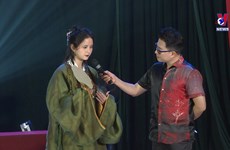Contest seeks to create Vietnam dance
The Hanoi Dancers Association has launched a competition to choreograph a
typical Vietnamese dance.
The Hanoi Dancers Association has launched a competition to choreograph a
typical Vietnamese dance.
The main purpose of the competition is to create a dance featuring traditional moves while being easy for people to perform.
The same competition was held in 1988 and nine dances won top prizes, which were performed at some subsequent events but were then gradually forgotten.
“In the past we had some dances that were nameless and died,” said People’s Artist Ung Duy Thinh. “That’s why the most important thing is not the composition or the music, but how to maintain it and develop it throughout the community.”
Thinh further said that he had also helped organise a competition for composing ten dances for military forces. The dances were popular at first, but they faded quickly.
Thinh warned that the dancing community should be careful not to make the same mistake again.
“A Vietnamese dance is like a new product, which should have its own consumers and time to be popularised among the community,” said dancer Ly Van Phuc. “As in business, we should invest properly in advertising while practising and maintaining the dances to make them come alive.”
Many dancers shared the same point of view that Vietnamese people, in general, do not have any typical dances.
Various dances of ethnic minority groups have been used at cultural events like mua sap (dance with bamboo poles) of Thai ethnic groups, dance with gongs of ethnic groups in central highlands and the dance with a bamboo flute of the Mong ethnic group.
Today’s youth in cities prefer hiphop, salsa and ballroom dancing./.
The main purpose of the competition is to create a dance featuring traditional moves while being easy for people to perform.
The same competition was held in 1988 and nine dances won top prizes, which were performed at some subsequent events but were then gradually forgotten.
“In the past we had some dances that were nameless and died,” said People’s Artist Ung Duy Thinh. “That’s why the most important thing is not the composition or the music, but how to maintain it and develop it throughout the community.”
Thinh further said that he had also helped organise a competition for composing ten dances for military forces. The dances were popular at first, but they faded quickly.
Thinh warned that the dancing community should be careful not to make the same mistake again.
“A Vietnamese dance is like a new product, which should have its own consumers and time to be popularised among the community,” said dancer Ly Van Phuc. “As in business, we should invest properly in advertising while practising and maintaining the dances to make them come alive.”
Many dancers shared the same point of view that Vietnamese people, in general, do not have any typical dances.
Various dances of ethnic minority groups have been used at cultural events like mua sap (dance with bamboo poles) of Thai ethnic groups, dance with gongs of ethnic groups in central highlands and the dance with a bamboo flute of the Mong ethnic group.
Today’s youth in cities prefer hiphop, salsa and ballroom dancing./.













